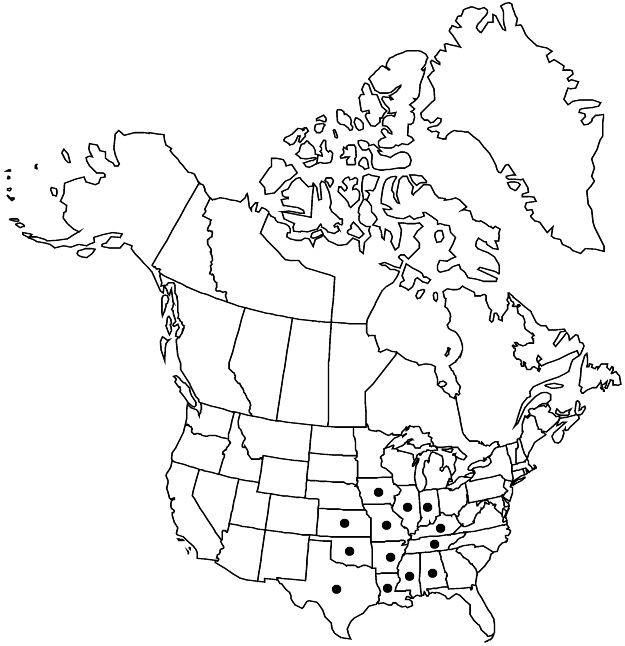Difference between revisions of "Prunus mexicana"
Proc. Amer. Acad. Arts 17: 353. 1882.
FNA>Volume Importer |
FNA>Volume Importer |
||
| Line 24: | Line 24: | ||
|elevation=10–400 m | |elevation=10–400 m | ||
|distribution=Ala.;Ark.;Ill.;Ind.;Iowa;Kans.;Ky.;La.;Miss.;Mo.;Okla.;Tenn.;Tex.;Mexico (Coahuila;Nuevo León;San Luis Potosí;Tamaulipas). | |distribution=Ala.;Ark.;Ill.;Ind.;Iowa;Kans.;Ky.;La.;Miss.;Mo.;Okla.;Tenn.;Tex.;Mexico (Coahuila;Nuevo León;San Luis Potosí;Tamaulipas). | ||
| − | |discussion=<p>As L. H. Shinners (1956b) pointed out, plums from Texas determined as Prunus americana var. lanata Sudworth are not P. americana but P. mexicana. This was extrapolated by others to mean that all hairy americana-type plums, which had been called var. lanata, are P. mexicana. As a consequence, P. mexicana is often listed from states far from where it truly occurs (for example, North Carolina, Ohio, Wisconsin) and herbarium sheets of hairy P. americana can often be found filed under P. mexicana.</p> | + | |discussion=<p>As L. H. Shinners (1956b) pointed out, plums from Texas determined as <i>Prunus americana</i> var. lanata Sudworth are not <i>P. americana</i> but <i>P. mexicana</i>. This was extrapolated by others to mean that all hairy americana-type plums, which had been called var. lanata, are <i>P. mexicana</i>. As a consequence, <i>P. mexicana</i> is often listed from states far from where it truly occurs (for example, North Carolina, Ohio, Wisconsin) and herbarium sheets of hairy <i>P. americana</i> can often be found filed under <i>P. mexicana</i>.</p> |
|tables= | |tables= | ||
|references= | |references= | ||
| Line 48: | Line 48: | ||
|publication year=1882 | |publication year=1882 | ||
|special status= | |special status= | ||
| − | |source xml=https://jpend@bitbucket.org/aafc-mbb/fna-data-curation.git/src/ | + | |source xml=https://jpend@bitbucket.org/aafc-mbb/fna-data-curation.git/src/8f726806613d60c220dc4493de13607dd3150896/coarse_grained_fna_xml/V9/V9_630.xml |
|subfamily=Rosaceae subfam. Amygdaloideae | |subfamily=Rosaceae subfam. Amygdaloideae | ||
|tribe=Rosaceae tribe Amygdaleae | |tribe=Rosaceae tribe Amygdaleae | ||
Revision as of 18:18, 18 September 2019
Trees, rarely suckering, 30–120 dm, sparsely thorny. Twigs with axillary end buds, usually glabrous, sometimes hairy. Leaves deciduous; petiole 4–18 mm, hairy, rarely only adaxially, usually glandular distally, glands 1–2(–4); blade usually elliptic, sometimes broadly elliptic, obovate, ovate, or oblong, 6–12 × 3–7 cm, base usually obtuse to broadly rounded, sometimes subcordate, margins coarsely, doubly serrate, teeth sharp, eglandular, apex usually abruptly acuminate to acuminate, rarely acute, abaxial surface densely hairy, adaxial rugose, glabrous or hairy. Inflorescences 2–5-flowered, umbellate fascicles. Pedicels 4–20 mm, usually glabrous, sometimes sparsely hairy. Flowers blooming before leaf emergence; hypanthium obconic, 2–4.5 mm, glabrous or hairy externally; sepals reflexed, ovate to lanceolate, 1.5–4 mm, margins entire or irregularly or obscurely glandular-toothed, sometimes 2-fid at apices, ciliate, surfaces hairy; petals white, sometimes turning pink, elliptic to obovate, 5–10 mm; ovaries glabrous. Drupes purplish red to dark blue, glaucous, subglobose to ellipsoid, 15–30 mm, glabrous; mesocarps fleshy; stones ovoid-ellipsoid, strongly flattened.
Phenology: Flowering Mar–Apr; fruiting Aug–Oct.
Habitat: Stream bottoms, open woods, edges of woods
Elevation: 10–400 m
Distribution

Ala., Ark., Ill., Ind., Iowa, Kans., Ky., La., Miss., Mo., Okla., Tenn., Tex., Mexico (Coahuila, Nuevo León, San Luis Potosí, Tamaulipas).
Discussion
As L. H. Shinners (1956b) pointed out, plums from Texas determined as Prunus americana var. lanata Sudworth are not P. americana but P. mexicana. This was extrapolated by others to mean that all hairy americana-type plums, which had been called var. lanata, are P. mexicana. As a consequence, P. mexicana is often listed from states far from where it truly occurs (for example, North Carolina, Ohio, Wisconsin) and herbarium sheets of hairy P. americana can often be found filed under P. mexicana.
Selected References
None.